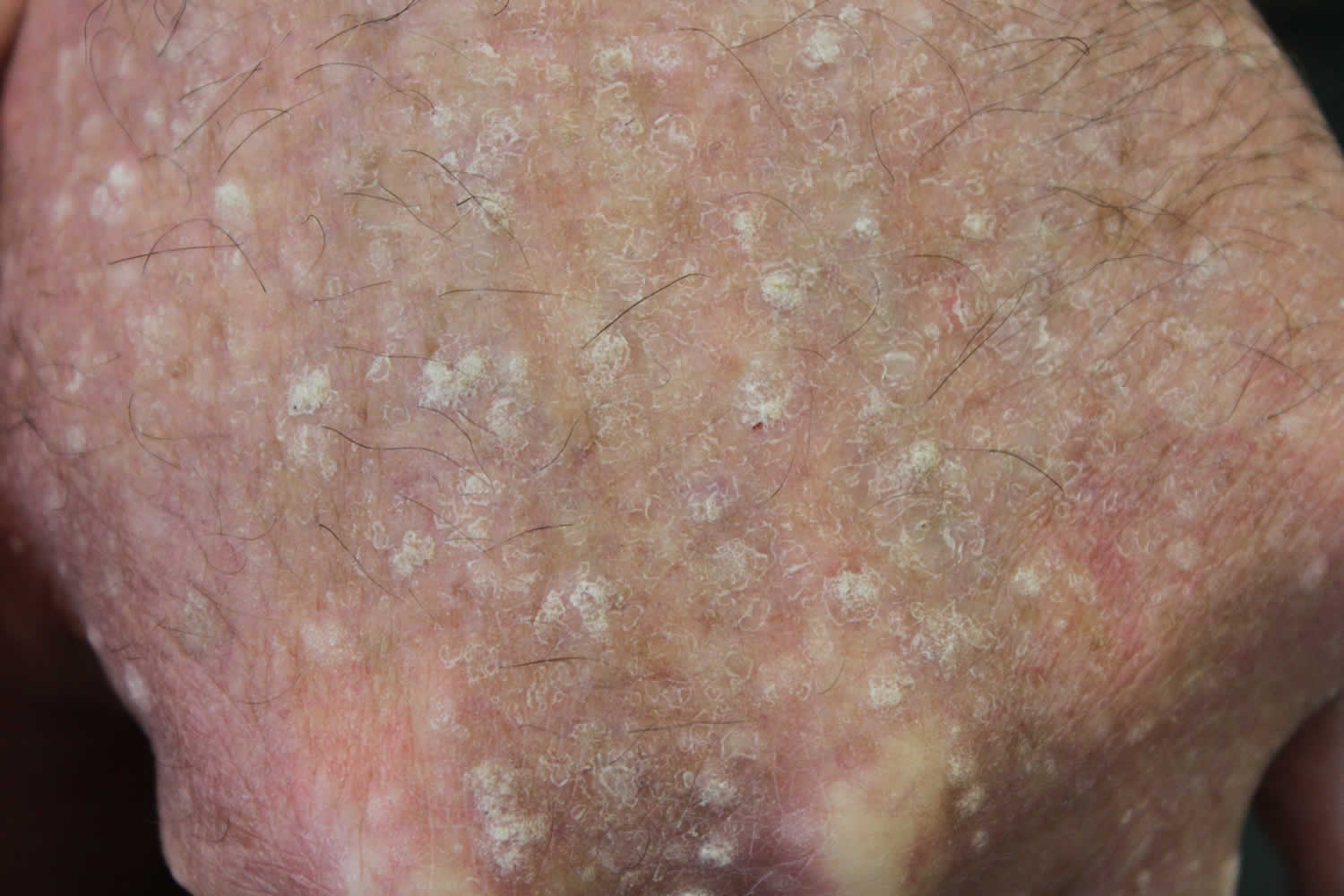What is stucco keratosis
Stucco keratosis is a benign keratotic papule that is usually found on the distal aspects of the lower limbs. Stucco keratosis is a benign lesion that is best regarded as a form of seborrheic keratosis 1. Stucco keratosis lesions appear as keratotic papules or plaques on the lower extremities but are sometimes found on the upper extremities, usually acrally. The lesions are typically less than 1 centimeter in size and are usually white in color. Usually, multiple lesions are found in stucco keratosis; in one study, between 7 and more than 100 lesions were noted on the patients. The lesion is asymptomatic, and patients usually do not complain of having the lesions. The name stucco keratosis is derived from the “stuck on” appearance of the lesions.
Stucco keratosis seems to appear with a higher frequency in males. The incidence of stucco keratosis is approximately 10% of the senior population in the United States. Stucco keratosis predominantly occurs in elderly men. The stucco keratosis lesions begin to appear around age 45 years.
Stucco keratosis is found in persons of all races. No reports have been noted on race as a factor in stucco keratosis.
Is stucco keratosis contagious?
No. The exact cause of stucco keratosis is unknown. Most patients report a history of prolonged or severe sun exposure but the relationship of this to the development of the lesions is uncertain. Surface friction may contribute to the development of the lesions.
Stucco keratosis causes
The exact cause of stucco keratosis is unknown. Most patients report a history of prolonged or severe solar exposure but the relationship of this to the development of the lesions is uncertain. Surface friction may contribute to the development of the lesions.
Stucco keratosis appears to be produced by thickening of the epidermis. On microscopic examination, the epidermis is usually exophytic with a church spire–like appearance. The surface may be regularly distributed into folds with elongation of papillae. The stratum corneum is thickened.
Surface friction may contribute to the development of stucco keratosis lesions. The tumor grows outward and does not penetrate into the dermis. The lesions are usually found in elderly patients.
With a nested polymerase chain reaction technique, human papillomavirus types 9, 16, 23b, DL322, and 37 were detected in a 75-year-old nonimmunosuppressed man with very extensive stucco keratosis lesions 2. This finding requires confirmation in other patients.
Various genetic mutations, including PIK3CA and FGFR3 have been reported in common seborrheic keratoses 3. A 2010 study demonstrated that three of five stucco keratosis samples revealed a PIK3CA mutation, but not the FGFR3 mutation 4. Further study will likely highlight the genetic background for stucco keratoses.
Stucco keratosis symptoms
Stucco keratosis lesions are often seen in elderly men. The stucco keratosis lesions are asymptomatic and usually go unnoticed by both the patient and the clinician.
Stucco keratosis distribution
- Lesions are numerous
- Mainly the lower legs. Also the forearms / dorsal hands
Stucco keratosis morphology
- Size – 1 to 10 mm in diameter
- Color – white / grey
- Macular lesions with a ‘stuck-on’ appearance
- Dry / rough surface
- Easily removed and do not bleed when come away
Stucco keratosis diagnosis
No laboratory or imaging studies are required in stucco keratosis. If the diagnosis is in question, then a shave biopsy can be performed to confirm the diagnosis.
Histologic Findings
A church spire–like epidermal hyperplasia similar to that in hyperkeratotic seborrheic keratosis is seen.
Stucco keratosis treatment
Stucco keratosis is a benign lesion that can be removed by curettage or cryotherapy.
Different methods or a combination of methods can be used to remove the stucco keratosis lesions. The most common methods in practice are liquid nitrogen therapy and curettage.
Liquid nitrogen therapy in stucco keratosis
Lesions can be frozen with liquid nitrogen by either the spray method or the dipstick method. Because the lesions are benign, the required temperature of the lesion should reach -25°C.
Depending on the thickness of the lesion, two freeze cycles of 3-10 seconds are usually required. The lesions fall off in a few days, and, if the procedure is not successful, liquid nitrogen therapy may be repeated. Ambient temperature and skin temperature, as well as underlying vascularity, must be taken into account. Ulceration can occur if cryotherapy is too vigorous.
Curettage in stucco keratosis
Stucco keratosis can be removed by curettage. Lesions can be removed by gentle scraping. Once the lesion is removed, topical petrolatum can be applied.
Other methods used in stucco keratosis
The lesion can be removed by using an electrodesiccator.
Shave removal is performed only if the lesion appears malignant, does not respond to cryotherapy and/or curettage, or requires a definitive diagnosis.
Long-Term Monitoring
Patients with stucco keratosis should be advised to have a periodic skin examination.
Stucco keratosis prognosis
The lesions of stucco keratosis are benign growths similar to those of seborrheic keratosis. Clinically, stucco keratosis lesions may be mistaken as a melanoma.
- Stucco keratosis. https://emedicine.medscape.com/article/1059798-overview[↩]
- Stockfleth E, Rowert J, Arndt R, Christophers E, Meyer T. Detection of human papillomavirus and response to topical 5% imiquimod in a case of stucco keratosis. Br J Dermatol. 2000 Oct. 143(4):846-50.[↩]
- Heidenreich B, Denisova E, Rachakonda S, Sanmartin O, Dereani T, Hosen I, et al. Genetic alterations in seborrheic keratoses. Oncotarget. 2017 Mar 30.[↩]
- Hafner C, Landthaler M, Mentzel T, Vogt T. FGFR3 and PIK3CA mutations in stucco keratosis and dermatosis papulosa nigra. Br J Dermatol. 2010 Mar. 162(3):508-12.[↩]





